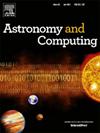基于贝叶斯统计和深度学习的Kaniadakis全息暗能量观测约束
IF 1.8
4区 物理与天体物理
Q2 ASTRONOMY & ASTROPHYSICS
引用次数: 0
摘要
本文提出了具有混合膨胀定律的Kaniadakis全息暗能量(KHDE)模型,该模型描述了宇宙在平坦的Friedmann-Lemaĩtre-Robertson-Walker宇宙中加速膨胀。在KHDE模型中获得的减速参数描述了宇宙从减速阶段到加速阶段的膨胀。KHDE模型的状态方程(EoS)参数再现了宇宙的丰富行为,例如跨越精粹时代的幻影分割线(ω>−1)。我们包括状态查找器对(r,s),它将来会模拟Λ CDM模型。利用贝叶斯统计、57个哈勃数据点、6个重子声学振荡(BAO)数据点和1048个万神殿Ia型超新星(SNIa)数据点提取模型约束。贝叶斯和人工神经网络的结果也进行了比较。采用基于人工神经网络的参数估计方法CoLFI。CoLFI对于参数估计更有效,特别是对于难以处理的似然函数或大型资源密集型宇宙模型。文中还详细讨论了模型的一些物理性质。本文章由计算机程序翻译,如有差异,请以英文原文为准。
Observational constraints using Bayesian Statistics and deep learning in Kaniadakis holographic dark energy
In this paper, we present the Kaniadakis holographic dark energy (KHDE) model with hybrid expansion law, which describes the Universe accelerating expansion in the flat Friedmann-Lematre-Robertson-Walker Universe. The deceleration parameter obtained in the KHDE model depicts the expansion of the universe from decelerating to an accelerating phase. The KHDE model’s equation of state (EoS) parameter reproduces the Cosmos’ rich behaviour, such as the phantom division line spanning the quintessence era (). We include the statefinder pair , which emulates the CDM model in the future. Bayesian Statistics and 57 Hubble data points, 6 baryonic acoustic oscillations data points, and 1048 Pantheon Type Ia supernovae data points are used to extract model constraints. Bayesian and findings are also compared. CoLFI, an ANN-based parameter estimation approach is employed. CoLFI is more efficient for parameter estimation, especially for intractable likelihood functions or big, resource-intensive cosmological models. Some physical properties of the model are also discussed in detail.
求助全文
通过发布文献求助,成功后即可免费获取论文全文。
去求助
来源期刊

Astronomy and Computing
ASTRONOMY & ASTROPHYSICSCOMPUTER SCIENCE,-COMPUTER SCIENCE, INTERDISCIPLINARY APPLICATIONS
CiteScore
4.10
自引率
8.00%
发文量
67
期刊介绍:
Astronomy and Computing is a peer-reviewed journal that focuses on the broad area between astronomy, computer science and information technology. The journal aims to publish the work of scientists and (software) engineers in all aspects of astronomical computing, including the collection, analysis, reduction, visualisation, preservation and dissemination of data, and the development of astronomical software and simulations. The journal covers applications for academic computer science techniques to astronomy, as well as novel applications of information technologies within astronomy.
 求助内容:
求助内容: 应助结果提醒方式:
应助结果提醒方式:


